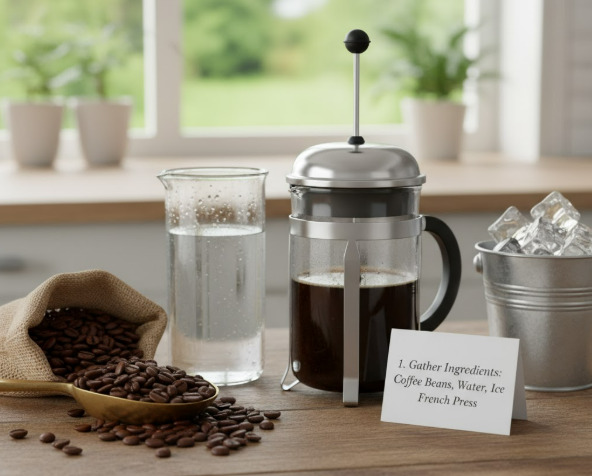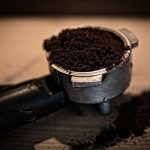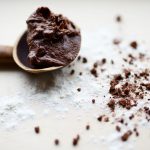Section 1: Introduction to Iced Coffee Extraction via Full Immersion
1.1 Defining the French Press in Iced Coffee Production: Immersion Brewing Mechanics
The French Press, historically a device associated with hot coffee, serves as a highly versatile full immersion brewer uniquely suited for producing various styles of iced coffee, ranging from low-acidity cold brew concentrate to bright, nuanced flash-chilled servings.1 The fundamental mechanical principle involves steeping coffee grounds in water for an extended period, allowing continuous contact that facilitates maximal flavor compound saturation.1
A defining characteristic of French Press brewing is its filtration system. Unlike infusion methods (such as pour-over or drip coffee) which rely on paper filters, the French Press employs a metal mesh screen.1 This metal filter has a larger pore size, allowing beneficial coffee oils and minute micro-grounds, often referred to as fines, to pass into the final liquid.1 This results in a coffee brew that is known for its heavy body and rich mouthfeel, contrasting significantly with the light, sediment-free cup characteristic of paper filtration.3 While this rich texture is highly valued, the inclusion of fines presents the primary challenge in quality control, often manifesting as sediment or a “muddy” texture in the final cup.5
1.2 Chemical Principles of Coffee Extraction: Temperature, Time, and Solubility
The resulting sensory profile of any iced coffee preparation is intrinsically linked to the chemical kinetics of extraction, which are controlled primarily by water temperature and contact time. These two variables govern the solubility of flavor compounds, sugars, acids, and bitter notes.
In Hot Extraction (utilized for Flash Chill methods), water temperatures typically range between 195–205°F (90°C–96°C).7 This high thermal energy facilitates a rapid and often “explosive” series of chemical reactions within the coffee grounds.8 The process is quick, often completed in 2 to 5 minutes, and efficiently extracts volatile aromatic compounds and desirable organic acids.8 The resulting flavor is full-flavored, possessing a brighter acidity and complexity that showcases the nuanced notes of the originating bean.4
Conversely, Cold Extraction (Cold Brew) uses cold or room-temperature water over an extended duration.9 The kinetic slowdown imposed by the low temperature dramatically minimizes the dissolution rate of compounds, particularly those responsible for bitterness and sharp acidity.8 This methodical, time-intensive process results in a brew that boasts significantly reduced acidity—up to 67% lower than a hot brew—yielding a profile that is notably smoother, often perceived as sweeter, and less complex in its aromatic structure.11
1.3 Overview of French Press Iced Coffee Methods: A Spectrum of Extraction
The French Press accommodates three distinct iced coffee preparation techniques, representing a spectrum of extraction efficiency and flavor profiles:
- Pure Cold Brew: This is the most straightforward method, involving continuous immersion for 12 to 24 hours in cold water. The primary goal is achieving maximum smoothness and a characteristic low-acid flavor profile.9
- Hot Bloom Hybrid: This technique modifies cold brew by introducing a brief, initial exposure to hot water (30–60 seconds). This strategic thermal shock rapidly extracts volatile aromas and maximizes caffeine content before the lengthy cold steeping process commences, balancing complexity with smoothness.11
- Flash Chill: Also known as Japanese Iced Coffee, this technique involves preparing a highly concentrated hot brew using standard parameters (4-minute steep time) and immediately pouring it over a pre-measured mass of ice. This rapid chilling preserves the bright acidity and aroma extracted by the hot water, preventing the bitterness associated with slow cooling.8
Section 2: Methodological Deep Dive: Comparative Analysis of Iced Coffee Processes
2.1 The Cold Brew Standard: Low-Acidity Extraction (French Press Cold Brew)
The Pure Cold Brew method leverages the French Press as a convenient, large-format immersion vessel. The objective is to achieve a low-acid concentration suitable for dilution and long-term storage.
2.1.1 Extraction Kinetics and Caffeine Content
The slow kinetics of cold water primarily dissolve sugars, oils, and melanoidins, suppressing the extraction of sharp organic acids.11 This slow process necessitates an extended steep time, typically 12 to 24 hours.9 While the extraction of flavor compounds is gradual, caffeine extraction is efficient, reaching approximately 80% extraction over the full cold brewing duration.11
2.1.2 Process and Concentration Ratios
The methodology requires preparing a concentrate, not a ready-to-drink beverage. The standard industry ratio for cold brew concentrate is substantially higher than hot coffee ratios. Recommendations specify approximately 4 Tbsp (20g to 22g) of coarse grounds for every 6 fl oz (180 ml) of cold or room-temperature water.9 This translates to a concentration ratio of approximately 1:8 to 1:9 (coffee:water by weight).
This highly concentrated approach is not merely for flavor, but is often a logistical choice driven by practical considerations. A highly concentrated product maximizes yield volume and promotes shelf stability. A highly concentrated brew, when stored in an airtight container and refrigerated, maintains its flavor integrity for up to two weeks, which is advantageous for bulk preparation.14 Therefore, the use of this high concentration ratio reflects an industry standard focused on logistical efficiency and maximizing longevity.
2.1.3 Step-by-Step Procedure for Cold Brew Concentrate
The procedure is relatively simple, requiring minimal intervention:
- Grinding: Add coarse grounds to the French Press.
- Water Addition: Pour cold or room-temperature water over the grounds.
- Saturation: Gently stir once or twice to ensure all grounds are fully saturated. Excessive or vigorous stirring must be avoided as it increases the production of fines and sediment.9
- Steeping: Secure the lid and place the French Press in the refrigerator for the 12 to 24 hour steep time.9
- Plunging and Dilution: Slowly depress the plunger. The concentrate must then be diluted prior to consumption, typically at a 1:1 ratio with water, milk, or a dairy alternative.9
2.2 The Hot Bloom Hybrid: Maximizing Aroma and Complexity
The Hot Bloom Hybrid technique is a refinement of the cold brew process, designed to bridge the gap between the aromatic complexity of hot extraction and the low-acid smoothness of cold immersion. It is often cited by coffee professionals as the optimal pathway for balanced cold brew.12
2.2.1 The Strategic Application of Thermal Shock
The strategic use of hot water for a brief duration initiates rapid extraction kinetics. Hot water efficiently and rapidly extracts the highly volatile aromatic compounds that cold water struggles to dissolve.11 Furthermore, nearly 90% of the coffee’s total caffeine content is released within the first minute of contact with hot water, compared to the 80% released over the full 12+ hour cold steep.11
This immediate, brief hot exposure (a “bloom”) effectively maximizes both aromatic complexity and caffeine release early in the process. The subsequent addition of cold water instantly halts the rapid acid extraction, allowing the remaining 12-24 hours of steeping to proceed under cold conditions, thus maintaining the signature low-acidity profile.11 This ability to obtain high caffeine levels and enhanced flavor complexity while preserving smoothness establishes the Hot Bloom as a highly sophisticated method.
2.2.2 Optimized Hot Bloom Recipe Parameters
A typical Hot Bloom employs a high coffee concentration similar to pure cold brew, but introduces a specific initial step:
- Add the required amount of coarse coffee grounds (e.g., 30g).
- Pour a small portion of boiling water (e.g., 1 cup) and allow it to steep for a brief period, typically 30 seconds.11
- Add the remaining water volume (e.g., 1.5 cups) as cold water and proceed with the standard 12–24 hour refrigerated steep.11
2.3 The Flash Chill Technique (Japanese Iced Coffee via FP): Speed and Clarity
The Flash Chill method leverages the French Press as a standard hot brewer, focusing on rapid chilling to preserve the quality of the hot extraction.
2.3.1 Principle of Rapid Extraction and Preservation
By brewing hot (195–205°F), the extraction is complete in approximately 4 minutes, ensuring a full spectrum of flavor complexity, including bright acids.7 Pouring this highly concentrated brew immediately over a measured quantity of ice arrests the chemical reactions, preventing the oxidation and staling that cause bitterness in coffee that is brewed hot and allowed to cool slowly (the “old way” of making iced coffee).8
2.3.2 Brewing Parameters and Ice Calculation
The Flash Chill method requires a standard coarse grind (1300–1400 µm) and a slightly lower coffee-to-water ratio than the cold brew concentrate. Precise measurement of both hot water and ice mass is necessary because the ice serves as the primary diluting agent.
For instance, a recipe utilizing 40g of coffee brewed with 400g of hot water requires 200g of ice for rapid chilling and dilution.13 This ensures the final dilution ratio results in an optimally strong and perfectly chilled ready-to-drink beverage, usually settling around a 1:10 ratio of coffee to total liquid (water plus melted ice).13
Table 1: Comparative Technical Parameters of French Press Iced Coffee Methods
| Parameter | Pure Cold Brew (CB) | Hot Bloom Hybrid | Flash Chill (Hot Brew) |
| Target Flavor Profile | Smooth, low acidity, heavy body | Complex, aromatic, balanced acidity | Bright, nuanced, high acidity |
| Water Temperature | Cold/Room Temp (0°C – 25°C) | Initial Hot Bloom (90°C-96°C), then Cold | Hot (90°C–96°C) 7 |
| Extraction Time | 12 to 24 hours 9 | 12 to 24 hours (total) 11 | 4 minutes (Hot Steep) 7 |
| Grind Size Recommendation | Extra Coarse (1400-1600 µm) 16 | Extra Coarse | Coarse (1300-1400 µm) 16 |
| Typical Ratio (Concentrate) | 1:9 (Coffee:Water) 9 | 1:9 | 1:10 (Total liquid including melted ice) 13 |
Section 3: Technical Specifications: Ingredients and Equipment Precision
3.1 The Critical Role of Grind Size and Uniformity
For any immersion method utilizing a mesh screen, grind size and particle uniformity are the most critical factors governing the final quality, directly impacting sediment levels and extraction efficiency.6
3.1.1 Micron Analysis for Immersion Brewing
The required grind size is fundamentally dependent on the duration and temperature of extraction. Cold brew, due to its extended steep time (12+ hours), requires an Extra Coarse grind, visually similar to rock salt, ranging from 1400 to 1600 \mum.16 This coarse size prevents severe over-extraction during the prolonged immersion and minimizes the production of fines that easily bypass the filter.16 Conversely, the Flash Chill method, with its rapid 4-minute extraction time, requires a slightly finer Coarse grind, comparable to coarse sea salt (1300–1400µm).16
This direct relationship between grind particle size and extraction time is a critical principle of French Press brewing. The need for an extra coarse grind in cold brew is a necessary kinetic compensation: cold water is less aggressive than hot water, but the duration of exposure (12 hours versus 4 minutes) demands larger particles to ensure a slow, even extraction. Misaligning these parameters—for example, using a standard coarse grind for cold brew—results in a rapid failure mode characterized by excessive bitterness and severe over-extraction.
3.1.2 Equipment and Sediment Mitigation
The consistency of the grind is as important as the size. The most common source of sediment and a “sludgy” cup is the use of a blade grinder, which produces an uneven distribution of particles, creating excessive fines.6 A high-quality burr grinder is therefore imperative, ensuring a coarse, uniform particle size that maximizes flavor clarity and minimizes the passage of fines through the mesh filter.15
3.2 Coffee-to-Water Ratios for Concentration and Dilution
Precise management of coffee-to-water ratios is essential, especially when dealing with cold brew concentrates designed for batch preparation.
3.2.1 Standard Concentrate Ratios
For Cold Brew, the ratio is intensely concentrated, typically 20 of coffee per 180 of water, equating to roughly 1:9 by weight.9 This deviates significantly from the standard hot brew ratio, which generally falls around 1:15 or 1:18.7 This high concentration is the defining feature of cold brew prepared for bulk storage.
3.2.2 Dilution Protocol for Serving
A fundamental requirement for serving cold brew concentrate is mandatory dilution. Consumers accustomed to ready-to-drink coffee must be aware that the concentrate is overwhelmingly strong if consumed neat. Upon serving, the optimal dilution ratio typically ranges from 1:1 (concentrate to water or milk) to 1:2 for a potentially weaker final cup.9 Adjusting this ratio is the primary mechanism for customizing the final strength and flavor intensity of the beverage.9
Table 2: Concentrate Ratio and Dilution Guide
| Concentrate Ratio (Weight) | Ratio Description | Coffee (g) per 100g Water | Dilution Recommendation (Concentrate:Water/Milk) | Target Final Brew Strength |
| 1:9 (Standard CB) 9 | Strong Concentrate | 11.1 | 1:1 14 | Standard Ready-to-Drink Coffee |
| 1:8 (Very Strong, Max Commercial) 19 | Extra Concentrated | 12.5 | 1:1.5 to 1:2 | Highly concentrated drinks (e.g., cocktails, thick lattes) |
| 1:4 (Ultra Concentrate) 19 | Extreme Concentrate | 25.0 | 1:3 to 1:4 | Highly viscous, used for extreme volume yield |
3.3 Bean Selection and Roast Profile: Optimizing for Extraction Temperature
The selection of the coffee bean’s roast profile must be aligned with the chosen extraction method to achieve the desired flavor outcome.
3.3.1 Selection for Cold Brew
Since cold water suppresses the extraction of desirable acids, beans that inherently possess deeper, richer flavor notes—such as dark roasts—are generally preferred for cold brew.20 Darker roasts often yield notes of chocolate, caramel, and earthiness, which are amplified in the low-acid environment.21 Furthermore, low-acid coffee brands or specific origins (like Honduran or certain organic single-origin beans) are actively sought out to maximize the smooth profile, particularly by consumers sensitive to acid reflux.20
3.3.2 Selection for Flash Chill
The Flash Chill method, relying on hot extraction, rapidly extracts bright acids and volatile aromatics. Therefore, beans known for their complex, nuanced, or brighter characteristics—often medium or lighter roasts—are ideally suited.4 For example, certain Peruvian or Bali Blue selections offer balanced acidity and complexity that translate well when rapidly chilled, allowing the inherent flavor notes of the high-quality bean to shine through.21 The professional brewer must actively decide the desired outcome (smoothness versus brightness) to dictate the extraction temperature and the appropriate bean selection.
Section 4: Quality Control and Troubleshooting: Achieving Clarity and Balance
The inherent mechanical limitations of the French Press require specific strategies to manage bitterness, over-extraction, and the omnipresent issue of sediment.
4.1 Mitigating Bitterness and Over-Extraction
Bitterness signals over-extraction, where undesirable phenolic compounds are excessively dissolved, often leading to a dry or astringent mouthfeel.22
4.1.1 Causes and Solutions for Cold Brew
In cold brew, over-extraction is primarily caused by steeping for too long (beyond 24 hours) 19 or using a grind that is too fine, which drastically increases the surface area exposed to water.15 The corrective action involves limiting the steep time (e.g., reducing from 24 to 16 hours) and ensuring an extra coarse, uniform grind.19
4.1.2 Causes and Solutions for Hot Brew
For Flash Chill, over-extraction is typically a function of excessive steep time or water temperature. Water must be 30 seconds off the boil to hit the optimal brewing range of 195–205°F.2 If bitterness occurs during a standard 4-minute steep, the time should be reduced by approximately 20 seconds.22
4.2 Resolving Sediment and Sludge (Muddy Texture)
The most persistent aesthetic and quality issue in French Press coffee is the presence of fine sediment, leading to a sludgy or muddy texture.5 This is unavoidable without advanced intervention due to the limitations of the metal mesh filter.
4.2.1 Causes of Sediment
The root causes include: the use of a non-uniform grinder, over-agitating the grounds during stirring, or plunging the mesh filter too forcefully or too far into the settled grounds.14 The plunger’s true function is separation, isolating the liquid from the grounds, not filtration in the micro-level sense. The bed of settled grounds actually forms a natural, primary filter layer, which must not be disturbed.15
4.2.2 Advanced Filtration Strategies for Clarity
To achieve a truly clean, professional-grade cup free of micro-grounds, secondary filtration is required. Once the plunger has been slowly and gently depressed—stopping short of agitating the grounds at the bottom 14—the resulting brew or concentrate should be poured through a secondary medium. Recommended options include filtering through a paper filter (such as a Chemex or standard drip filter set in a funnel), or using specialized materials like cheesecloth or dedicated felt Toddy filter bags.9 Implementing secondary filtration is not merely an improvement in clarity; it is a critical step in flavor stability. If the concentrate is stored with a significant quantity of residual fines, these particles continue to slowly extract flavor compounds over the two-week storage life, leading to a gradual drift toward over-extraction and bitterness. Removing the fines stabilizes the intended flavor profile.14
4.3 Concentrate Storage and Shelf Life
Effective storage is crucial for batch-prepared cold brew concentrate. Given the high concentration and low acidity, cold brew can be successfully preserved for up to two weeks, provided specific handling protocols are strictly followed.14 The concentrate must be transferred to a clean, airtight container and kept refrigerated. Limiting air contact prevents oxidation, staling, and the absorption of ambient odors and flavors from other items in the refrigerator.14
Section 5: Application and Flavor Innovation
5.1 Formulating Signature Iced Drinks (Lattes and Flavoring)
The intense flavor profile of French Press cold brew concentrate provides an ideal, robust foundation for creating specialty iced beverages.
5.1.1 The Iced Latte Framework
An Iced Latte typically combines strong coffee or concentrate, milk, and sweetener over ice.25 When using cold brew concentrate, the standard starting ratio is 1 part concentrate to 1 part milk (or cream).25 The use of a low-acid cold brew base is highly beneficial, as it ensures chemical stability when combined with dairy. High-acidity coffee (such as certain Flash Chill or standard hot brews) can sometimes clash with or even curdle milk, whereas cold brew’s minimal acid content guarantees a smoother, more palatable creamy texture.11
5.1.2 Flavoring Protocols
Vanilla syrup is a perennial favorite, typically added in measures of 1 to 2 tablespoons per serving.25 Other common pairings include specific syrups such as caramel, brown sugar, or chocolate (mocha) syrup.26 For greater convenience, certain pre-made creamers and flavor bases are effective complements to the robust cold brew flavor.27
5.2 Advanced Cold Brew Infusions and Pairings
The low acidity of cold brew presents a clean, neutral canvas that complements deep, complex flavor additions without flavor antagonism.
5.2.1 Optimizing Flavor Pairings
Flavors that naturally harmonize with the rich, deep, and sometimes earthy notes of dark roast cold brew are typically preferred. Cinnamon is a highly recommended spice, providing a complementary kick.27 Natural sweeteners such as honey add an agreeable sweetness and depth when paired with a strong cold brew.28 The combination of cocoa, cinnamon, and sugar can also be blended and sprinkled over the beverage, optionally topped with whipped cream.28
5.2.2 Cold Infusion Techniques
For flavor integration that runs deeper than mere syrup mixing, aromatic components can be incorporated directly into the French Press alongside the coffee grounds during the 12-hour cold steep. Examples include cinnamon sticks, vanilla beans, or small amounts of dried cocoa nibs. This technique leverages the immersion environment to achieve a true cold infusion, ensuring the flavor is fully integrated into the concentrate itself.
Conclusions and Recommendations
The French Press is established as a highly adaptable instrument for producing high-quality iced coffee, provided the brewer accounts for the device’s specific mechanical and thermal constraints. The choice among the three primary methods—Pure Cold Brew, Hot Bloom Hybrid, or Flash Chill—must be dictated by the desired flavor profile: maximum smoothness (Pure Cold Brew), optimal aromatic complexity and caffeine content (Hot Bloom), or bright acidity (Flash Chill).
The analysis yields several critical technical recommendations for achieving expert-level results:
- Mandatory Grind Precision: The correlation between extraction time/temperature and particle size is non-negotiable. Cold brew necessitates an extra coarse grind (1400–1600µm) to prevent over-extraction during long steeping periods, while Flash Chill requires a standard coarse grind (1300–1400µm). A high-quality burr grinder is essential for uniformity.15
- Dilution Protocol for Concentrates: The industry standard for French Press cold brew is production of a 1:8 to 1:9 concentrate, driven by logistical efficiency and shelf stability. This concentrate absolutely requires post-brewing dilution, typically 1:1 or higher, to prevent serving an unbalanced beverage.9
- Required Secondary Filtration: The French Press mesh filter is a separation tool, not a micro-filtration device. To eliminate sediment and prevent the delayed over-extraction caused by fines during concentrate storage, pouring the concentrate through a secondary paper filter or felt medium is highly recommended.24 This step ensures flavor stability over the concentrate’s two-week shelf life.14
- Optimal Method Selection for Specialty Drinks: For preparing smooth, chemically stable iced lattes and flavored drinks that utilize dairy or non-dairy milk, the French Press Cold Brew concentrate is the superior base due to its inherently low acidity.11 Conversely, if the goal is to highlight the subtle, acidic nuances of a single-origin bean, the Flash Chill method is required.4
Karya yang dikutip
- French Press vs. Pour Over vs. Drip: Which is Right for You? – Methodical Coffee, diakses November 5, 2025, https://methodicalcoffee.com/blogs/coffee-culture/french-press-vs-pour-over-vs-drip-which-is-right-for-you
- Advantages (and Disadvantages) of Brewing Your Coffee With a French Press, diakses November 5, 2025, https://www.franklygoodcoffee.com/blog/advantages-of-french-press-brewing
- Comparing drip coffee vs. French press – Breville, diakses November 5, 2025, https://www.breville.com/us/en/blog/coffee-and-espresso/drip-coffee-vs-french-press.html
- French Press vs Pour Over Coffee: Discover Which Is Better For You – ESPRO, diakses November 5, 2025, https://espro.com/blogs/coffee-talk/espro-french-press-vs-pour-over
- French Press vs. Pour Over: Pros & Cons of Each Manual Brewing Method, diakses November 5, 2025, https://www.williams-sonoma.com/pages/tips-and-ideas/french-press-vs-pour-over/
- diakses November 5, 2025, https://somethingsbrewing.in/blogs/brewing-tips/common-french-press-mistakes-how-to-fix-them#:~:text=4.,particles%20passing%20through%20the%20filter.
- How to Brew with a Coffee Press – Starbucks® at Home, diakses November 5, 2025, https://athome.starbucks.com/brewing-guide/how-brew-coffee-press
- Battle of the Brews: Hot, Iced, and Cold Brew Coffee Explained – ESPRO, diakses November 5, 2025, https://espro.com/blogs/coffee-talk/battle-of-the-brews
- How to Brew Cold Brew with a Coffee Press – Starbucks® at Home, diakses November 5, 2025, https://athome.starbucks.com/brewing-guide/how-brew-cold-brew-coffee-press
- How to Make Cold Brew Coffee Using a French Press, diakses November 5, 2025, https://www.manateecoffee.com/blogs/news/how-to-make-cold-brew-coffee-using-a-french-press
- Cold Brew Hot Bloom Method – DripBeans, diakses November 5, 2025, https://dripbeans.com/cold-brew-hot-bloom-method/
- TIL just how much more flavor you get from blooming cold brew : r/Coffee – Reddit, diakses November 5, 2025, https://www.reddit.com/r/Coffee/comments/5ygsp5/til_just_how_much_more_flavor_you_get_from/
- Iced Coffee With French Press – 5 Minute Recipe – YouTube, diakses November 5, 2025, https://www.youtube.com/watch?v=iB9bWf-qsKs
- How to Make French Press Cold Brew Concentrate – Fonté Coffee …, diakses November 5, 2025, https://www.fontecoffee.com/blog/how-to-make-french-press-cold-brew-concentrate/
- What to Do When Your French Press Coffee Is Muddy or Sludgy, diakses November 5, 2025, https://brewclancoffee.com/blogs/specialty-coffee-guide/what-to-do-when-your-french-press-coffee-is-muddy-or-sludgy
- The Ultimate Guide to Coffee Grind Size, diakses November 5, 2025, https://blog.genuineorigin.com/2025/05/the-ultimate-guide-to-coffee-grind-size/
- Coffee grind size chart, diakses November 5, 2025, https://honestcoffeeguide.com/coffee-grind-size-chart/
- How to Make French Press Coffee | Brew Guide, diakses November 5, 2025, https://kaldiscoffee.com/blogs/recipes/how-to-make-french-press-coffee
- How to Make Cold Brew Coffee in a French Press (step-by-step) – The Wooden Skillet, diakses November 5, 2025, https://thewoodenskillet.com/cold-brew-coffee-french-press/
- Best Coffee For Cold Brew: My Top 7 Picks! – Gurl Gone Green, diakses November 5, 2025, https://gurlgonegreen.com/2023/05/16/best-coffee-for-cold-brew/
- Best Coffee for Iced Coffee: The Ultimate Guide to Choosing Perfect Beans for Cold Brewing, diakses November 5, 2025, https://www.everydaypeoplecoffeeandtea.com/blogs/news/best-coffee-for-iced-coffee-the-ultimate-guide-to-choosing-perfect-beans-for-cold-brewing
- Why Your Cafetiere Coffee Tastes Bad | The Journal – Barista & Co, diakses November 5, 2025, https://baristaandco.com/blogs/news/why-your-cafetiere-coffee-tastes-bad
- I get a bitter residue from my French press coffee. Any way to change that? – Reddit, diakses November 5, 2025, https://www.reddit.com/r/Coffee/comments/6edogc/i_get_a_bitter_residue_from_my_french_press/
- my cold brew always has grounds at the bottom, what am i doing wrong? or how can i get rid of them? : r/Coffee – Reddit, diakses November 5, 2025, https://www.reddit.com/r/Coffee/comments/bpsm1j/my_cold_brew_always_has_grounds_at_the_bottom/
- Iced Vanilla Latte Recipe (Starbucks Copycat) – One Sweet Appetite, diakses November 5, 2025, https://onesweetappetite.com/iced-vanilla-latte/
- Share your French press recipe (if you want) : r/barista – Reddit, diakses November 5, 2025, https://www.reddit.com/r/barista/comments/1dt1l3b/share_your_french_press_recipe_if_you_want/
- Delicious Cold Brew Combos: Perfect Pairings for Your Coffee! – Lemon8-app, diakses November 5, 2025, https://www.lemon8-app.com/raquelkooi/7227463914576740870?region=us
- 11 Must-Try Pairings with Cold Brew Coffee – Ovalware, diakses November 5, 2025, https://www.ovalware.com/blogs/oval-blog/11-must-try-pairings-with-cold-brew-coffee





